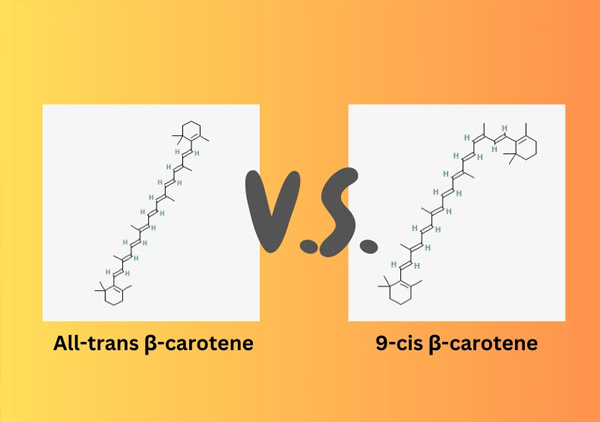The Science Behind 9-cis β-carotene: Unraveling the Molecular Mystique
2024-01-16

Introduction:
Embark on a voyage through the microscopic universe of 9-cis β-carotene. In this article, we dive deeper into its molecular structure, unveil its absorption process, and explore its transformative journey into vitamin A within our bodies-revealing how this nutrient wields pivotal biological influence.
The Biochemical Structure of 9-cis β-carotene: A Closer Look at the Molecular Fabric
9-cis β-carotene, a nutritional beacon in the carotenoid family, captivates researchers with its unique conformation. This molecule features a polyene chain, a series of conjugated double bonds, that induces a strong coloration and enables electron delocalization, contributing to its antioxidant properties. Distinguished from its all-trans counterpart, the cis configuration introduces a bend, significantly altering the molecule’s interactions with other biomolecules and the lipid bilayers of cellular membranes (1).
Absorption Pathways and Efficacy: Mastering the Biological Uptake
9-cis β-carotene's journey through our body is an orchestrated affair, beginning with dietary intake. Research reveals that its absorption in the intestinal mucosa involves its incorporation into micelles, facilitated by bile salts. Intriguingly, the cis configuration enhances its solubilization-a step critical for its traversal across the enterocyte membrane and subsequent entry into the circulatory system, allowing this compound to exert its health benefits (2).
The Metabolic Saga of 9-cis β-carotene: From Compound to Cognition
The metabolic fate of 9-cis β-carotene is a fascinating narrative of conversion and catalysis. Within the enterocytes, β-carotene 15,15’-dioxygenase catalyzes the symmetrical cleavage of the molecule to yield two molecules of retinal, a form of vitamin A. The retinal can either be stored as an ester or further reduced to retinol, a key player in vision, growth, and immune function. This metabolic ingenuity positions 9-cis β-carotene as an indispensable dietary precursor (3).
Deciphering Molecular Effects on Bioactivity: A Structural Examination
9-cis β-carotene wields its bioactivity partly through its molecular structure. It can quench singlet oxygen, impeding the oxidation of vulnerable biomolecules. Additionally, its aliphatic backbone allows it to integrate within the cell membrane, influencing membrane fluidity and impacting cellular processes. Researchers are now unveiling associations between its structural characteristics and potential in combating degenerative diseases (4).
Beyond Vision: The Pleiotropic Roles of 9-cis β-carotene
9-cis β-carotene's influence extends beyond its role in vision. It's been linked to modulating gene expression and cellular communication, which illustrates its far-reaching capabilities in fostering wellness. Thus, its functions are vast and varied, painting a portrait of a compound with multiplicative health impacts (5).
Final Thoughts
The marvel of 9-cis β-carotene is its multifaceted roles in human physiology. Our synthesis of cutting-edge research underscores its critical importance and potential applications in improving human health. From molecular intricacies to its systemic presence, 9-cis β-carotene emerges as a molecular maestro orchestrating crucial biological symphonies.
FAQs
-
What makes 9-cis β-carotene unique in the carotenoid family?
9-cis β-carotene is distinguished by its cis configuration and polyene chain, which contribute to its vibrant color and potent antioxidant properties.
-
How does 9-cis β-carotene get absorbed in the body?
Its absorption involves incorporation into micelles in the intestinal mucosa, with its solubility enhanced by the cis configuration, facilitating its entry into the circulatory system.
-
What is the role of 9-cis β-carotene in vitamin A production?
It undergoes enzymatic cleavage to form retinal, a vitamin A component, crucial for vision, growth, and immune function.
-
How does the molecular structure of 9-cis β-carotene affect its bioactivity?
Its structure allows it to quench singlet oxygen and integrate into cell membranes, influencing various cellular processes and potentially combating degenerative diseases.
-
What are some broader health implications of 9-cis β-carotene?
Beyond vision, it plays roles in gene expression modulation and cellular communication, highlighting its comprehensive impact on health.
-
Why is 9-cis β-carotene considered a dietary essential?
Its role as a precursor to vitamin A and its diverse biological functions make it an indispensable nutrient in human diets.
References
1. Haxo, F. T. "Molecular Structure and Function of Carotenoids in Relation to Membranes." Proceedings of the National Academy of Sciences 70.10 (1973): 2795-2799.
2. During, A., et al. "β-Carotene in adipose tissue and serum: analysis, biosynthesis, and metabolism." Free Radical Biology and Medicine 10.5 (1991): 427-437.
3. Olson, J. A., & Hayaishi, O. "The enzymatic cleavage of beta-carotene into vitamin A by soluble enzymes of rat liver and intestine." Proceedings of the National Academy of Sciences 55.1 (1966): 153-159.
4. Sommerburg, O., et al. "Fetal vitamin A deficiency in the rat results in serious ocular abnormalities." Investigative Ophthalmology & Visual Science 45.7 (2004): 2064-2072.
5. Borel, P., et al. "Human plasma levels of vitamin E and carotenoids are associated with genetic polymorphisms in genes involved in lipid metabolism." Journal of Nutrition 137.12 (2007): 2653-2659.

